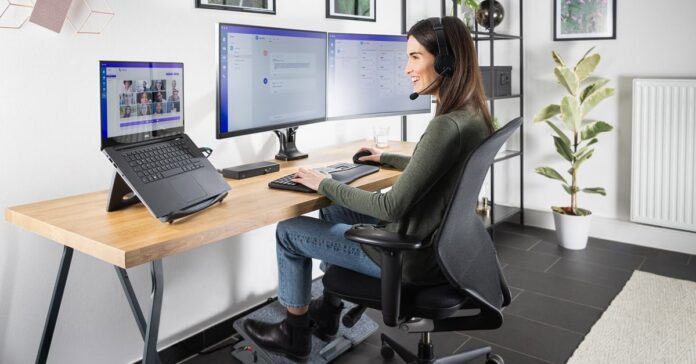In the modern professional era, the home office has transitioned from a simple luxury to an absolute necessity for many. With the undeniable surge in remote work due to technological advancements and recent global events, an efficiently designed workspace is paramount. Ergonomics is not just a fancy buzzword; it’s the bridge to the ideal balance between comfort and productivity. Here, we delve into the world of ergonomics, unveiling its significance and demonstrating how an ergonomic home office can transform your daily work routine.
Benefits of Ergonomics
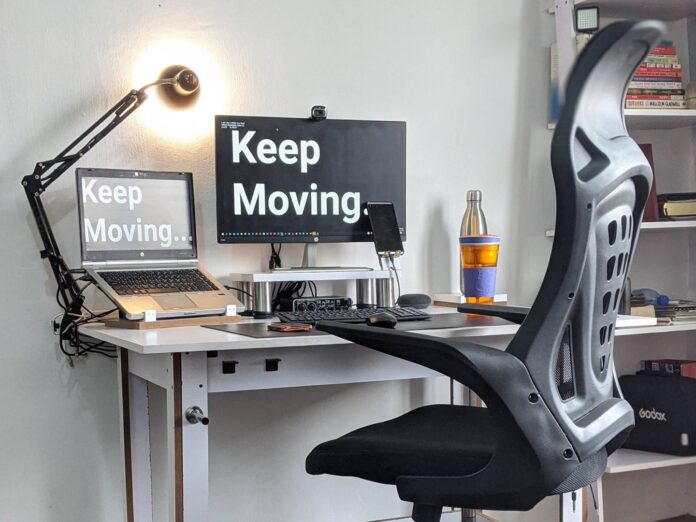
At its core, ergonomics concerns optimizing workspaces to cater to the individual needs of users, ensuring maximum efficiency and comfort. Embracing ergonomics brings forth a cascade of benefits:
Improved Comfort: An ergonomic setup means each element, from your chair to your screen, works in harmony with your body. This harmony eradicates the common discomforts many professionals battle daily, such as hunching over keyboards or struggling with recurrent neck strains and backaches.
Enhanced Productivity: When you’re comfortable, your ability to focus escalates. Distractions diminish, and concentration peaks. Research is on board with this: A study from Cornell University highlighted a whopping 17% increase in productivity following ergonomic interventions.
Better Health: Beyond immediate comfort, ergonomics has long-term health implications. Musculoskeletal disorders, which include a range of conditions affecting muscles, bones, and joints, can be mitigated or even prevented with the right setup. The Bureau of Labor Statistics noted that in 2019, musculoskeletal disorders accounted for one-third of all days-away-from-work cases. Thus, investing in ergonomics is also investing in your long-term health.
Choosing the Right Location

Determining where to set up your home office is as crucial as deciding on the equipment you’ll use. Here are some pointers for making this critical decision:
Quietness: Finding a serene spot, shielded from household or neighborhood noise, allows for better focus and minimizes distractions. Soundproofing, even if basic, can be a game-changer, especially for those in bustling urban areas or households with lively children.
Natural Light: Spaces with access to ample natural light are not just uplifting but also reduce eyestrain. Positioning your desk near a window can make your workspace more invigorating. However, ensure direct sunlight doesn’t create screen glare.
Dedicated Space: If possible, allocate a room or a distinct area solely for work. This segregation helps mentally differentiate ‘work mode’ from ‘home mode’, making transitions smoother and enhancing work-life balance.
Ergonomic Desk and Chair
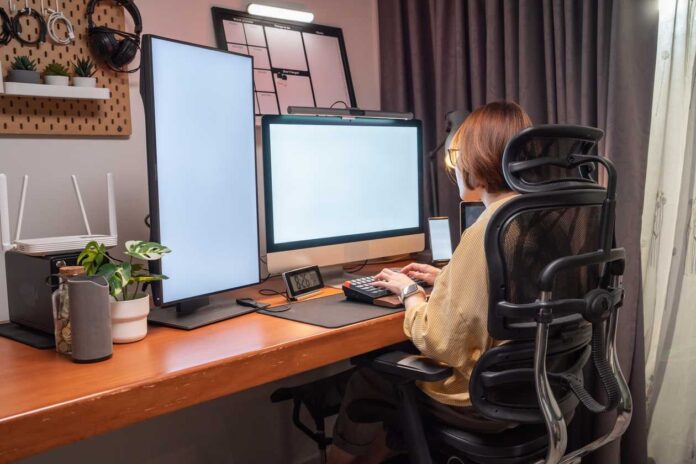
The foundation of any ergonomic setup lies in the selection of the right desk and chair. This duo will be your daily companions, and their synergy is indispensable for your well-being.
Desks: An adjustable sit stand desk offers versatility, allowing both sitting and standing options. The depth should accommodate your computer, keyboard, and any additional resources while granting you sufficient space to avoid hunching. Consider desks with rounded edges to prevent forearm discomfort.
Chairs: An ergonomic chair supports the natural curve of your spine, provides ample cushioning, and has adjustable armrests and height settings. The ideal chair allows your feet to rest flat on the ground and your knees at a 90-degree angle. Remember, the priciest option isn’t necessarily the best. It’s about fit and comfort.
Monitor Placement and Height
Your monitor’s position can be a silent culprit behind many ergonomic issues. Here’s how to optimize:
Eye Level: The top of the screen should align with or be slightly below your eye level when seated. This alignment prevents you from tilting your head, averting neck and back strain.
Distance: Ideally, your monitor should be an arm’s length away. Fonts should be clear and legible without squinting. Investing in a larger screen can alleviate the strain and enhance productivity, especially if your work involves multiple windows or applications.
Keyboard and Mouse Setup
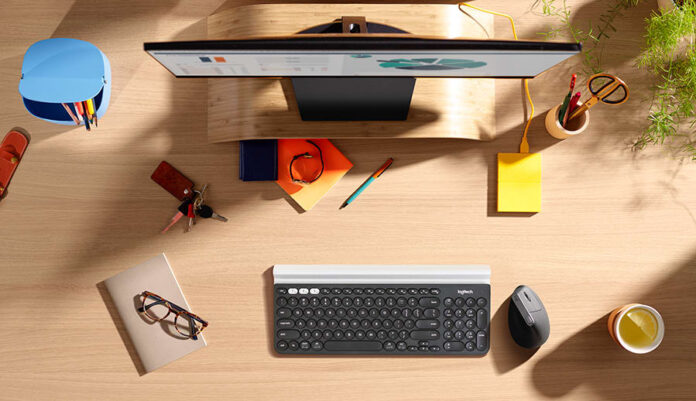
These frequently-used tools deserve ergonomic attention. The right setup not only boosts productivity but also shields you from potential strain.
Keyboard: An ergonomic keyboard typically has a slight curve, making typing more intuitive and less straining. Your wrists should remain in a neutral position, neither flexed nor extended. Consider a keyboard tray if your desk height isn’t adjustable.
Mouse: Ergonomic mice come in various shapes, designed to fit the natural grip of the hand. The key is to find one that feels comfortable during prolonged use. Your elbow should remain close to your body and form an angle between 90 and 120 degrees.
Organizing Cables and Accessories
An organized workspace isn’t just about aesthetics. It’s an essential element of an ergonomic setup.
Cable Management: Tangled cables can be potential tripping hazards and make cleaning or rearranging cumbersome. Use cable ties, sleeves, or under-desk trays to keep them in check.
Accessories Positioning: Items used frequently, like phones or notepads, should be within arm’s reach. This minimizes unnecessary stretching or twisting, optimizing movement efficiency.
Lighting and Ergonomics

Lighting influences productivity and eye comfort. Poor lighting can induce headaches, eye strains, and fatigue.
Natural vs. Artificial: While natural light is preferred, it’s crucial to balance it with artificial sources to prevent shadows or glares. LED lights with adjustable brightness and warmth can mimic natural light and are energy-efficient.
Positioning: Light sources should be positioned parallel or behind your viewing direction. Avoid placing them directly in front or behind the monitor to dodge screen glare.
Ergonomic Accessories
Beyond the basics, accessories can provide added layers of comfort, enhancing the ergonomic value of your workspace.
Monitor Stands: If your monitor isn’t adjustable, stands or mounts can help in achieving the right height, ensuring you don’t strain your neck.
Footrests: These support your feet, especially if your chair is tall. They ensure that your feet have a resting platform, promoting blood circulation.
Lumbar Supports: These are pillows or cushions that fit the curve of your back, providing support to the lumbar region, essential for those with back concerns.
Proper Posture and Breaks
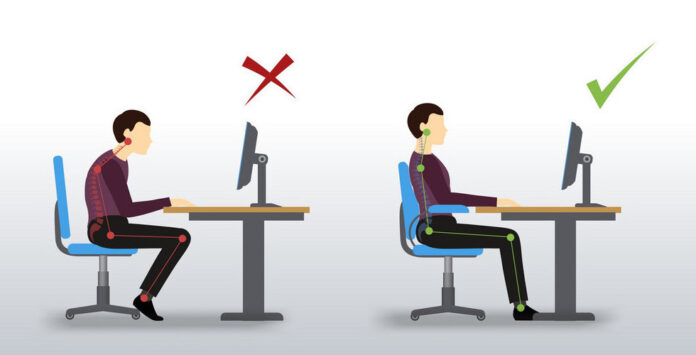
All the ergonomic gear won’t help if you don’t maintain proper posture. Sit back in your chair, keep your feet flat, and elbows close. Remember the 20-20-20 rule: every 20 minutes, look at something 20 feet away for at least 20 seconds. Additionally, stand, stretch, or walk briefly every hour to rejuvenate your body and mind.
Personalization and Adjustability
Ergonomics isn’t a one-size-fits-all solution. Everyone’s body, habits, and work differ. Ensure that your furniture and accessories have adjustability features. Personal touches like plants or calming colors can also make the space more inviting and ergonomically effective.

